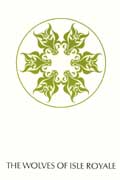.gif)
MENU
Methods and Extent of Present Research
![]() Wolf-Moose Coaction
Wolf-Moose Coaction
|
Fauna of the National Parks — No. 7
The Wolves of Isle Royale |

|
DYNAMICS OF WOLF-MOOSE COACTION
Future of the Wolves and Moose
Apparently the Isle Royale wolf population has increased to its maximum (under present conditions), for if it were going to increase further, it would have done so years ago. Numbers may fluctuate every few years, but probably there will be no significant variation. It seems likely that as long as the large pack remains on the island, the smaller groups will not breed. As individuals from these groups die of old age, the large pack may increase by a few members, although old animals from this pack may drop out and form other small groups; this also may stimulate breeding in the large pack. This is purely conjecture, however, for we know very little about the effects of pack interaction on breeding. Of course, emigration or immigration could complicate the whole situation. The most likely cause of variations in size of the wolf population probably would be a significant change in moose numbers.
The moose herd should remain stable for the next several years. Certainly if the wolves were going to deplete the population, they would have done so by now; instead they seem to have kept the herd within its food supply, culled out undesirable individuals, and stimulated reproduction. Indeed, the Isle Royale moose population probably is one of the best "managed" big-game herds in North America.
However, moose are dependent on the vegetation, and they flourish on earlier successional stages. Cowan et al. (1950) reported that, in British Columbia, moose numbers declined as the forest approached climax. These authors found that later successional stages supplied only about a third as much browse as earlier stages, and in regard to quality, they concluded (p. 249) the following:
There is an increase of carotene values and possibly of total mineral content in the vegetation on more advanced forest areas, but . . . in ascorbic acid content, ether extractives, total carbohydrates, and proteins, the vegetation upon the younger forest areas is superior to that on older areas.
One of the primary sources of winter browse on Isle Royale is the 1936 burn (figure 8), but the trees in much of this area are fast growing out of reach of the moose. Since modern fire detection systems make it improbable that many forest fires will escape in the future, it appears that within the next decade the moose population will decrease significantly, with a corresponding decline in wolf numbers. The level that either population will reach is unpredictable, but continued study of both wolf and moose throughout this period should prove highly enlightening.
 Top
Top
Last Modified: Thurs, Jul 4 2002 10:00:00 pm PDT
http://www.cr.nps.gov/history/online_books/fauna7/fauna6c.htm
![]()
